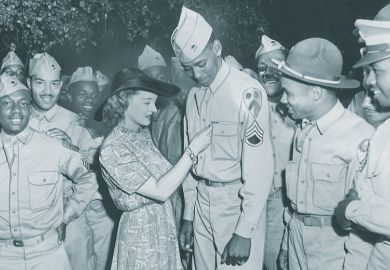On the face of it, Shakespeare is the perfect source for film and television. Art-house status combined with high-concept stories, universal themes, dollops of sex and violence, rich characters, exotic locations - and all out of copyright. The trouble is with the words. There are too many words. Also, as Jack Gold is quoted as saying in a brilliant piece by Mich le Willems in this collection of 14 essays: "People on the stage seem to be speaking in a foreign language." Yes and no. Some of Shakespeare's words are extremely familiar. Fragments are unknowingly quoted every day by millions. Whatever constituted the original stuff of the English language before the big bang which broadcast it throughout the known univese, a good portion of it was captured and used by Shakespeare.
Then, who do you make Shakespeare films for? There are Eng.Lit. students who watch, mentally moving a finger on the score, and those who, in David Jones's words, "do not know how the story will end". But nothing ventured . . . "A Selective Filmography" by Graham Holderness and Christopher McCullough lists 316 screen productions. The contributors get stuck into explaining the differences between "presenting", "adapting", "translating" and "interpreting" Shakespeare and, en passant, ruminate on the language and essence of theatre, cinema and television.
Editor Anthony Davies in "Filming Othello" observes that "there is an aesthetic clash between the centripetal function of the actor on the theatre stage and the centrifugal dynamic of the cinema". That is, in the theatre one's interest radiates away from the actor and in the cinema the actor sucks in attention from the background.
Most contributors refer to a seminal work, Shakespeare on Film by Jack Jorgens, who offers three categories of Shakespeare films: theatrical, realist and filmic. "Theatrical" implies a straight record of a theatrical production. The limitations of this form are obvious and give the writers little trouble.
The "realist" film treats the play as a screenplay and uses sets, locations, props and costume as most films do. The problem is how can the actors read those lines in realist settings; lines that Willems describes as "oratorical, formalistic, ironical, metaphorical . . . and which not only carry the dramatic energy but (are) also fraught with symbols and networks of metaphors". She grudgingly concedes that audiences derive pleasure from a literal depiction of Shakespeare's world of castles, courts, forests, ceremony and battles but she reserves top marks for the third category - the "filmic". This is "the mode of the film poet whose works bear the same relationship to the surfaces of reality that poems do to ordinary conversation" - ie, stylisation. Thus overall, the further a film is from Shakespeare as playwright and the more distant from conventional film-making, the better it is. Violence to the text is OK if it shows a cinematic spirit of independence. One of the finest examples of "filmic" adaptation is Akira Kurasawa's Throne of Blood.
Peter Holland in "Two-dimensional Shakespeare - King Lear" vividly summons Peter Brook's film, relishing every jump cut, zoom, soft focus, fade out and camera judder. Brook seems to hurl the recipe book in after the ingredients. A "filmic" interpretation with a vengeance.
BBC TV's complete Shakespeare is considered separately. The original brief was to make authentic, unabridged versions with no malarkey: that is, stretches of the camera pointing at actors speechifying. Over the years the policy was bent a little. And we hear how Jonathan Miller, Jane Howell, Elijah Moshinsky and Trevor Nunn subverted or enhanced TV's "naturalistic and even domestic" style.
Neil Taylor observes in "Two types of television Shakespeare": "In the theatre the set is all before us, but in film and television each new shot creates a new set." To speak of the background of a shot, which may or may not be in focus, as a "set" is bizarre. Taylor thinks the audience is Alzheimeric, forgetting between shots. In fact, it can chew gum and walk at the same time: a "set" in, say, a close-up is not new if the close-up follows a medium or long shot. Taylor admires Howell's work. "Although the set's residual force was part of a metatheatrical statement ('This is a play'), the fact it was inconsistently naturalistic, and susceptible of merely abstract or geometrical readings, suppressed its denotive and spatial significance." There are, of course, people who savour this kind of denseness, but I cross the road to avoid them.
On the page, in the theatre and on the screen Shakespeare continues to fascinate, tease and challenge. He is in a category all his own. Audiences treat Shakespeare films as pieces of classical music. Each film, like a performance, is only one interpretation; there is always another way. I wish the writers of Shakespeare and the Moving Image surprised me more with their interpretations of the existing ways.
Mamoun Hassan produced and presented Channel Four's Movie Masterclass. He teaches at the National Film and Television School.
Shakespeare and the Moving Image
Editor - Anthony Davies and Stanley Wells
ISBN - 0 521 43424 6 and 43573 0
Publisher - Cambridge University Press
Price - £37.50 and £12.95
Pages - 266
Register to continue
Why register?
- Registration is free and only takes a moment
- Once registered, you can read 3 articles a month
- Sign up for our newsletter
Subscribe
Or subscribe for unlimited access to:
- Unlimited access to news, views, insights & reviews
- Digital editions
- Digital access to THE’s university and college rankings analysis
Already registered or a current subscriber? Login



